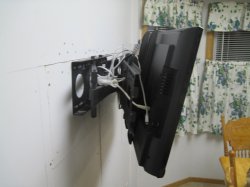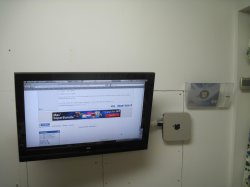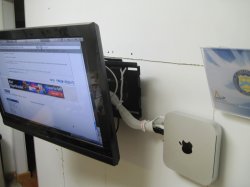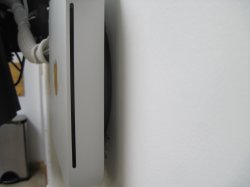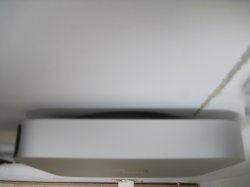Anyone done this? It seems like I could just plop the TB display on top of the Mac Mini and save all that room. I don't see how this could be a problem other than potential weight problems and heating, but the aluminum foot of the TB should act as a heat dissipater, right?
Got a tip for us?
Let us know
Become a MacRumors Supporter for $50/year with no ads, ability to filter front page stories, and private forums.
Can I set a Thunderbolt Display on top of a Mac Mini, using it as a stand?
- Thread starter Sean Dempsey
- Start date
- Sort by reaction score
You are using an out of date browser. It may not display this or other websites correctly.
You should upgrade or use an alternative browser.
You should upgrade or use an alternative browser.
Anyone done this? It seems like I could just plop the TB display on top of the Mac Mini and save all that room. I don't see how this could be a problem other than potential weight problems and heating, but the aluminum foot of the TB should act as a heat dissipater, right?
yes.. like this: from OWC

This is a glamorous one with a USB Hub.. you can buy 'plain' ones too...
for instance: http://www.newertech.com/products/nustand.php
you may have reception for wireless issues. I Would not want that much weight on the mini. the stand would help
I wouldn't recommend putting that much weight on top of the mini. It is probably fine to do so, but I would rather buy a stand line the one above then risk my 600+ computer.
I wouldn't recommend putting that much weight on top of the mini. It is probably fine to do so, but I would rather buy a stand line the one above then risk my 600+ computer.
I agree completely. I don't think it's a good idea without the stand.
Not to mention that if you need to access the mini you would have to move the monitor on and off, the stand is the safest way to go and looks cool.
I use wired ethernet.
Why would I need to access the Mac Mini if I am connected with a single thunderbolt cable?
Really if the heat/weight isn't an issue, it sounds like it would be fine.
Why would I need to access the Mac Mini if I am connected with a single thunderbolt cable?
Really if the heat/weight isn't an issue, it sounds like it would be fine.
I use wired ethernet.
Why would I need to access the Mac Mini if I am connected with a single thunderbolt cable?
Really if the heat/weight isn't an issue, it sounds like it would be fine.
well you may want a backup hdd to connect to the mini or put in a camera card .
I use wired ethernet.
Why would I need to access the Mac Mini if I am connected with a single thunderbolt cable?
Really if the heat/weight isn't an issue, it sounds like it would be fine.
You asked a question and you got answers, including several indicating the heat and weight are likely to be an issue. If you were going to do it regardless, then just go ahead and do it.
Computers have components designed to draw heat out. They don't need more heat being pumped into them.
You asked a question and you got answers, including several indicating the heat and weight are likely to be an issue. If you were going to do it regardless, then just go ahead and do it.
Computers have components designed to draw heat out. They don't need more heat being pumped into them.
Right, but an aluminum mac mini case is the heatsync. So by having the aluminum foot of the Display touching the mac mini, we've just added MORE heatsync for the heat to radiate too and be dissipated. It's like the fins on a CPU heatsync, eventually if the fins are long enough, they will be totally cool at the top since the heat is fully dissipated before it reaches the end of the aluminum.
I guess that's where I am curious. If the case is metal and that's how it gets cooled, then having a metal extension on the top should cool it better, not more, since it's heat conductive. If it was plastic or wood, yeah it would overheat it. But this is like putting a BIGGER heatsync on it.
As far as the weight, as long as it doesn't bend the case, then it shouldn't even matter since the edges of the mac mini case can probably support far more than the monitor weights.
Am I wrong on the idea that by having the metal touch metal, it would increase the cooling since the aluminum draws heat away much better than air does.
You asked a question and you got answers, including several indicating the heat and weight are likely to be an issue. If you were going to do it regardless, then just go ahead and do it.
Computers have components designed to draw heat out. They don't need more heat being pumped into them.
I agree. I would never do this. Companies like Apple employ product engineers who determine how products are to be used, safely, etc. This is certainly not a recommended setup. And I'm not sure that the additional height off the table/desk surface is a good idea, if the monitor gets knocked it has further to fall. It's just like I wouldn't put my LCD TV on a pedestal the size of the TV's base (not unless it was somehow screwed down). Just use the products the way they are designed to be used.
Ya know, if you are just going to do it, why bother asking? Rather than spend a few bucks on a stand designed to do what you want, you want to possibly endanger your mac mini. Fine. Do it. It might work just fine and you can come back here in a year or two and gloat.
I just wouldn't do it.
I just wouldn't do it.
Right, but an aluminum mac mini case is the heatsync. So by having the aluminum foot of the Display touching the mac mini, we've just added MORE heatsync for the heat to radiate too and be dissipated. It's like the fins on a CPU heatsync, eventually if the fins are long enough, they will be totally cool at the top since the heat is fully dissipated before it reaches the end of the aluminum.
I guess that's where I am curious. If the case is metal and that's how it gets cooled, then having a metal extension on the top should cool it better, not more, since it's heat conductive. If it was plastic or wood, yeah it would overheat it. But this is like putting a BIGGER heatsync on it.
As far as the weight, as long as it doesn't bend the case, then it shouldn't even matter since the edges of the mac mini case can probably support far more than the monitor weights.
Am I wrong on the idea that by having the metal touch metal, it would increase the cooling since the aluminum draws heat away much better than air does.
you are correct about the heat, but the black apple is plastic for a reason reception if you are fully hardwired no problem.
the real problem is weight and not where you think. the bottom of the mini is light plastic and smaller you will have a balance issue. there is a way to do what you want but it is not cheap. I will post a link. and a photo
this is what you would have to buy;
http://www.amazon.com/H-Squared-Mini-Mount-mini-Unibody/dp/B004JQPF3S/ref=pd_cp_e_0
It is metal and about 1/8 taller then the normal plastic base. screw it down to the desk and the mini would be firm and not rock. I have one and wall mounted my mini.
the above is not a guess.
the below is only a guess
(if you also got a 3/16 to 1/4 inch thick piece of aluminum cut to be an exact fit to the mini's top it would prevent bending of the minis top.)
I will post a photo of my wall install I replaced my imac with a 32 inch jvc and a mini
Attachments
Last edited:
As an Amazon Associate, MacRumors earns a commission from qualifying purchases made through links in this post.
Right, but an aluminum mac mini case is the heatsync. So by having the aluminum foot of the Display touching the mac mini, we've just added MORE heatsync for the heat to radiate too and be dissipated. It's like the fins on a CPU heatsync, eventually if the fins are long enough, they will be totally cool at the top since the heat is fully dissipated before it reaches the end of the aluminum.
I guess that's where I am curious. If the case is metal and that's how it gets cooled, then having a metal extension on the top should cool it better, not more, since it's heat conductive. If it was plastic or wood, yeah it would overheat it. But this is like putting a BIGGER heatsync on it.
As far as the weight, as long as it doesn't bend the case, then it shouldn't even matter since the edges of the mac mini case can probably support far more than the monitor weights.
Am I wrong on the idea that by having the metal touch metal, it would increase the cooling since the aluminum draws heat away much better than air does.
I'm no expert, but I do know that heat sinks are normally bonded to the item they're cooling using special heat conductive glue, just resting the stand on top of the mini is not the same as adding a bonded heatsink, and may actually insulate the heat from dissipating.
You've got it backwards, put the Mini on the display:
http://www.123macmini.com/accessories/guide/stands.html
http://www.123macmini.com/accessories/guide/stands.html
You've got it backwards, put the Mini on the display:
http://www.123macmini.com/accessories/guide/stands.html
I'm not sure that would work.. looking at the TBD it doesn't appear to employ the "VESA" standard fixings. Unless there is another attachment method... for the mini to the rear of the TBD.
one last photo. if you purchased the wall mount and mount the mini to the desk. if you put a thin piece of perfectly cut aluminum on the mini then the acd on the aluminum slab. it would work. it think it would also look good. and as someone mentioned heat sink paste would be needed. it would look nice IMO oh this mini is on the wall I am above it with the camera and pointing down. I was going to post this setup once I patched the wall,but the op's idea has crossed my mind. I knew the mini would wobble as I have tested his idea with my 2010 mini and my 2009 imac.
Attachments
The mini has a cooling fan. The case may help some with heat. But it uses a standard slot type cooling fan for laptops. Which does the intake and exhaust through a slot in the rear.
As long as the Mini is the same length and width as the display stand it should be able to hold it. If the display stand is narrower in could cause the case to warp over time. If it is wider it could cause stability issues. The other issue is scratching the Mini's case.
As long as the Mini is the same length and width as the display stand it should be able to hold it. If the display stand is narrower in could cause the case to warp over time. If it is wider it could cause stability issues. The other issue is scratching the Mini's case.
As far as I can tell, no one has mentioned that from an ergonomic standpoint the display will be raised way too high... unless you are around seven feet tall.
iMacs and the Thunderbolt display lack height adjustment, which is one of the main reasons that I won't be replacing my current C2D 24" iMac with another iMac.
If you raise the display too high you risk suffering from serious neck pain. I had that problem with my iMac and I was barely able to make it work for me. And I'm an average-size male at 5'10". I'm using a standard computer desk and chair. I researched replacement options and even expensive well-known computer desks would not solve the problem. Besides, one shouldn't have to spend in excess of $1000 on furniture in order to be able to use a computer without suffering from health problems...
Guidelines for proper display placement generally state that the top edge of the display should be at eye level. The more you have to look up, the more likely you will experience neck and shoulder discomfort.
Unfortunately, Apple has traded form over function when it comes to its recent computer and display designs. "Glassy" low-quality LED-backlit displays in its portables and equally-reflective LED displays in its iMacs and Thunderbolt displays that also lack basic ergonomic adjustments lead me to wonder whether Apple's designers actually use the products they create.
Granted, the 15" and 17" MacBook Pros have an anti-glare display option but only in high-resolution, which isn't desirable for many people.
In December I purchased a high-end NEC display that can be lowered to within 3" of the desktop vs. almost 6" with an iMac. Some NEC displays can be lowered to a point where it almost touches the desk.
An added bonus is that the NEC display is CCFL backlit so it isn't a problem for LED-sensitive people. And the quality of the display simply beats the pants off the iMac and Thunderbolt display panels.
The only "advantage" the Thunderbolt display has is that it connects via the Thunderbolt port (so does my NEC using an Apple DVI adapter...) and it is made out of aluminum. BFD...
iMacs and the Thunderbolt display lack height adjustment, which is one of the main reasons that I won't be replacing my current C2D 24" iMac with another iMac.
If you raise the display too high you risk suffering from serious neck pain. I had that problem with my iMac and I was barely able to make it work for me. And I'm an average-size male at 5'10". I'm using a standard computer desk and chair. I researched replacement options and even expensive well-known computer desks would not solve the problem. Besides, one shouldn't have to spend in excess of $1000 on furniture in order to be able to use a computer without suffering from health problems...
Guidelines for proper display placement generally state that the top edge of the display should be at eye level. The more you have to look up, the more likely you will experience neck and shoulder discomfort.
Unfortunately, Apple has traded form over function when it comes to its recent computer and display designs. "Glassy" low-quality LED-backlit displays in its portables and equally-reflective LED displays in its iMacs and Thunderbolt displays that also lack basic ergonomic adjustments lead me to wonder whether Apple's designers actually use the products they create.
Granted, the 15" and 17" MacBook Pros have an anti-glare display option but only in high-resolution, which isn't desirable for many people.
In December I purchased a high-end NEC display that can be lowered to within 3" of the desktop vs. almost 6" with an iMac. Some NEC displays can be lowered to a point where it almost touches the desk.
An added bonus is that the NEC display is CCFL backlit so it isn't a problem for LED-sensitive people. And the quality of the display simply beats the pants off the iMac and Thunderbolt display panels.
The only "advantage" the Thunderbolt display has is that it connects via the Thunderbolt port (so does my NEC using an Apple DVI adapter...) and it is made out of aluminum. BFD...
Last edited:
I would not place anything on a 2011 Mac mini. I had 4 stacked the top Mac mini was 10C cooler on average.
Well, it's annoying that they don't just have it built in (neither does my latest Acer), but there is this:I'm not sure that would work.. looking at the TBD it doesn't appear to employ the "VESA" standard fixings. Unless there is another attachment method... for the mini to the rear of the TBD.
http://store.apple.com/us/product/M9649G/A?fnode=MTY1NDA5OQ
Also good for ergonomics, potentially.
I am trying to figure out what people are sensitive to LEDs, but I can't even find a reference. LEDs are almost universally superior to CCFLs in every way. Except current cost, but that is a supply issue. And they have absolutely nothing to do with the glass in front of them.
Last edited:
I am trying to figure out what people are sensitive to LEDs, but I can't even find a reference.
A search via Google should turn up multiple references to the issue. Here's one to get you started:
http://texyt.com/bright+blue+leds+annoyance+health+risks
There is also a lengthy thread on the Apple forums that began in August 2008 after Apple introduced unibody portables with different LED displays than previous models.
https://discussions.apple.com/thread/1677617?start=0&tstart=0
LEDs are almost universally superior to CCFLs in every way.
That may be your opinion but it isn't shared by everyone. Again, there is plenty of information available online but I'll offer two examples that took maybe ten seconds to find:
Excepted from http://en.wikipedia.org/wiki/Backlight#Flicker_due_to_backlight_dimming
Flicker due to backlight dimming
LED backlights are often dimmed by applying pulse-width modulation to the supply current, switching the backlight off and on again like a fast strobe light. If the frequency of the pulse-width modulation is too low and or the user is very sensitive to flicker, this may cause discomfort and eye-strain, similar to the flicker of CRT displays. This can be tested by a user simply by waving a hand or object in front of the screen. If the object appears to have sharply-defined edges as it moves, the backlight is strobing on and off at a fairly low frequency. If the object appears blurry, the display either has a continuously-illuminated backlight or it is operating at a frequency that is too high for the brain to perceive. The flicker can be reduced or eliminated by setting the display to full brightness, though this has a negative impact on image quality and battery life due to increased power consumption.
Excerpted from
http://www.tomshardware.com/reviews/ccfl-led-backlight,2930-16.html
Looking across all nine of these monitors, we can generalize and say that LEDs definitely look more dramatic. The blacks are deeper, the whites brighter, and the colors more vibrant. At the same time, we found LEDs more prone to skewing toward a given color and needing more calibration in order to remedy this. CCFL displays often look semi-lifeless when sitting next to an LED, but their colors appear more photo-realistic. CCFL definitely renders more detail in shadows because the blacks haven’t been pushed down as strongly. Yes, sometimes the measurement data contradicts this, but we’re going by side-by-side visual comparisons, and it’s important to weigh both.
CCFL backlighting isn't perfect either. There is so much variation in panel types and quality that it is difficult to generalize about panel characteristics. But in the "prosumer" price range I think that it is safe to say that CCFL displays tend to be higher quality than LED and cause less eyestrain. Consumer displays tend toward LED because they are available in less expensive versions than CCFL panels. The industry is also moving toward LED as part of the trend to lower energy consumption in consumer electronics. There are some very high-end LED backlit displays but they are a different animal than consumer panels and they require careful calibration to obtain the best results. In my experience the cheaper LED panels are more problematic for some people than the better quality panels.
Since display preference is very subjective, I recommend choosing a panel type based on what you will be using it for. And be sure to buy from a retailer with a decent return policy should it not suit you.
Last edited:
As far as I can tell, no one has mentioned that from an ergonomic standpoint the display will be raised way too high... unless you are around seven feet tall.
Guidelines for proper display placement generally state that the top edge of the display should be at eye level. The more you have to look up, the more likely you will experience neck and shoulder discomfort.
Wrong.
Guidelines for proper display ergonomics say that the line at the top 1/3rd of the display is proper ergonomics. Sitting level, your eyes should line up 1/3rd of the way down the monitor, especially on big screens like this.
Wrong right back at ya!
Having your eye-level at a line dividing the middle and upper third portion of a display would still be too low. Better to look down slightly than to be looking up.
Unless you wear bifocals and have to tip your head up to read the monitor to begin with. Having the monitor too high leads to neck pain....I know...I bought the VESA adapter and an Ergotron heavy duty stand to mount my 24" iMac on (had to be heavy duty to hold the added weight of the iMac over a "normal" 24" monitor). Why Apple won't make a height adjustable stand for iMacs and monitors is beyond me.
Register on MacRumors! This sidebar will go away, and you'll see fewer ads.


